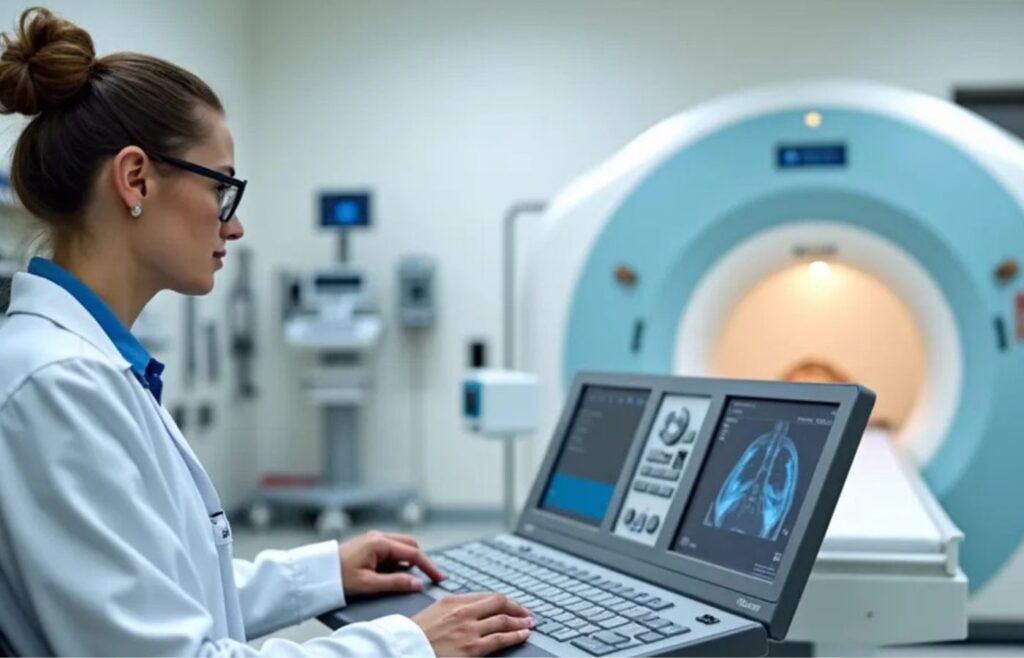Computed Tomography (CT) has revolutionized diagnostic imaging, offering rapid, high-resolution insights into the human body. For students pursuing a diploma in CT scan technician, staying abreast of the latest CT scan machines and emerging CT scan technology is crucial. Whether you’re enrolled at Diagnopein Paramedical or another top institute, here’s an 800-word deep dive into what you need to know.
1. Understanding How CT Scan Works
At its core, a CT scanner uses a rotating X-ray source and a series of detectors to collect cross-sectional images. During a scan, multiple X-ray beams pass through the patient at various angles. The detector array records the attenuated beams, and a computer reconstructs these raw data into detailed slices. These slices can then be stacked to form 3D representations of anatomy—crucial for diagnosing fractures, tumors, and vascular conditions.
Key CT scan procedure steps include:
- Patient positioning on the gantry table
- Selection of scan protocol (head, chest, abdomen, etc.)
- Contrast administration when required
- Image acquisition through rotational scanning
- Image reconstruction & post-processing
Familiarity with these steps not only smooths your practical sessions but also deepens your theoretical understanding of how CT scan works.
2. Types of CT Scan and Their Applications
Modern CT scanners support a variety of specialized protocols:
- Single-slice vs. Multi-slice CT: Multi-slice (16-, 64-, 128-slice) scanners allow faster scans with thinner slices for finer detail.
- Helical (Spiral) CT: The table moves continuously, enabling rapid volumetric acquisitions—ideal for trauma and vascular studies.
- Dual-energy CT: Uses two energy spectra to differentiate materials (e.g., iodine from calcium), improving tissue characterization.
- Cone-Beam CT (CBCT): Offers high-resolution imaging for dental and orthopedic applications with lower radiation doses.
As part of your CT scan technician training, you’ll learn the strengths and limitations of each type of CT scan, ensuring you can select the optimal protocol for every clinical scenario.
3. Advancements in CT Scan Technology
The field is evolving rapidly, with several notable advancements in CT scan over the past few years:
- Photon-Counting CT: Uses direct conversion detectors for improved spatial resolution and material decomposition without increased dose.
- AI-Enhanced Reconstruction: Artificial intelligence algorithms reduce noise and artifacts, allowing high-quality images at reduced radiation doses.
- Automated Protocol Selection: Smart software recommends the best scan parameters based on patient size and clinical indication.
- Portable CT Scanners: Compact units for emergency rooms and intensive care units, enabling bedside imaging without patient transport.
Staying updated on these breakthroughs will position you at the forefront of your profession and will be a highlight of your credentials when you complete your CT scan technician course.
4. Essential Skills for CT Scan Technicians
Beyond machine operation, successful technicians master a blend of technical and interpersonal competencies:
- Equipment Calibration & Maintenance: Regular phantom scans and quality checks keep the scanner in peak condition.
- Radiation Safety & Dose Optimization: Understanding the ALARA (As Low As Reasonably Achievable) principle and using shielding to protect patients and staff.
- Patient Communication & Positioning: Clear instructions help reduce motion artifacts and retakes.
- Image Post-Processing: Generating multiplanar reconstructions (MPR), maximum-intensity projections (MIP), and 3D volume renderings.
Institutes like Diagnopein Paramedical emphasize these skills for CT scan technician in their curriculum, ensuring graduates are practice-ready from day one.
5. Safety Tips for Students in CT Scanning Labs
Radiation safety is paramount. Adhere to these CT scan safety tips for students to protect yourself and your peers:
- Wear Personal Dosimeters: Monitor your cumulative exposure.
- Use Lead Aprons & Thyroid Shields: Whenever you’re near the gantry during manual positioning.
- Stand Behind Protective Barriers: Or at least 2 meters away from the isocenter during exposure.
- Follow Lab SOPs: Never bypass interlock systems or emergency-stop procedures.
These precautions are central to your medical lab internship tips and will become second nature as you log hours in the scanning suite.
6. CT Scan Internship Guidance & Lab Success
A structured clinical lab internship bridges textbook theory and real-world practice. To maximize your learning:
- Review Scanner Manuals Beforehand: Know the controls, menu systems, and error codes.
- Shadow Experienced Technicians: Observe their patient-handling techniques and troubleshooting workflows.
- Take Initiative: Volunteer to set up contrast injectors, prepare protocols, and assist in post-processing.
- Document Your Cases: Maintain a log of exams performed, scan parameters used, and any challenges encountered.
By following these CT scan internship guidance pointers—and applying how to excel in lab technician internship strategies—you’ll build confidence and a robust skill portfolio.
7. Choosing the Right CT Scan Technician Course
When selecting a CT scan technician course in India, consider:
- Accredited Institutes: Look for programs recognized by state health universities or national regulatory bodies.
- Hands-On Training Facilities: High slice-count CT scanners and dedicated simulation labs.
- Placement Support: Partnerships with hospitals and diagnostic chains for guaranteed internships and job placements.
A diploma in CT scan technician from a reputable institute not only covers the essentials of CT scan technology but also integrates medical lab internship tips and soft-skill development sessions, setting you on a fast track to career success.
Conclusion
The landscape of CT scanning is more dynamic than ever. From advancements in CT scan hardware and AI-driven software to a diverse array of types of CT scan, today’s technicians must blend technical acumen with safety vigilance and patient-centered communication. By mastering CT scan procedure steps, building core skills for CT scan technician, and leveraging CT scan internship guidance, students will emerge well-prepared for the demands of modern radiology departments. Stay curious, embrace continuous learning, and you’ll not only excel in your diploma in CT scan technician but also contribute meaningfully to the future of diagnostic imaging.

